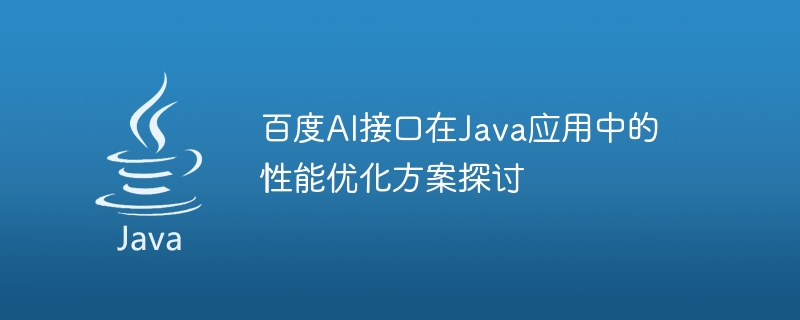Home >Java >javaTutorial >Discussion on performance optimization solutions of Baidu AI interface in Java applications
Discussion on performance optimization solutions of Baidu AI interface in Java applications
- WBOYWBOYWBOYWBOYWBOYWBOYWBOYWBOYWBOYWBOYWBOYWBOYWBOriginal
- 2023-08-27 12:45:401373browse

Discussion on performance optimization solutions of Baidu AI interface in Java applications
Introduction:
With the continuous development of artificial intelligence technology, Baidu AI interface has become a One of the popular tools used by developers. Using Baidu AI interface in Java applications can bring us a lot of convenience, but it may also cause performance bottlenecks. This article will explore some optimization solutions to help developers improve performance when using Baidu AI interfaces.
1. Overview
Baidu AI interface provides functions such as face recognition, text recognition, speech synthesis, etc. However, in actual applications, since the calling process of the interface involves network communication, data serialization and Operations such as deserialization can easily lead to performance degradation. In order to improve performance, we can optimize from the following aspects.
2. Reduce the number of interface calls
First, we can try to reduce the number of interface calls, which can reduce network communication overhead. For example, for the text recognition interface, if we need to recognize text in multiple pictures, we can merge these pictures into one request for batch recognition, instead of calling the interface separately for recognition.
Sample code:
// 创建图片识别请求列表
List<OCRRequest> requests = new ArrayList<>();
// 批量添加请求
requests.add(new OCRRequest(image1));
requests.add(new OCRRequest(image2));
...
// 批量调用接口
List<OCRResponse> responses = ocrClient.batchRecognize(requests);
// 处理响应结果
for (OCRResponse response : responses) {
processOCRResult(response);
}By merging images into one request, the number of interface calls can be reduced and performance improved.
3. Reasonable use of cache
Secondly, we can use cache reasonably to reduce repeated calculations and interface calls. For some interfaces with relatively stable request results, the results can be cached for a period of time to improve performance.
Sample code:
// 创建缓存对象
Cache<String, String> cache = CacheBuilder.newBuilder()
.expireAfterWrite(1, TimeUnit.HOURS)
.build();
// 尝试从缓存中获取结果
String result = cache.getIfPresent(requestKey);
// 缓存中不存在,调用接口获取结果,并将结果存入缓存
if (result == null) {
result = aiClient.callAPI(request);
cache.put(requestKey, result);
}By rationally using cache, you can avoid repeated calculations and interface calls and improve performance.
4. Multi-threaded concurrent processing
In addition, we can use multi-threaded concurrent processing to make full use of the multi-core characteristics of the CPU and improve the concurrency capability of interface calls.
Sample code:
ExecutorService executor = Executors.newFixedThreadPool(10);
List<Callable<String>> tasks = new ArrayList<>();
for (int i = 0; i < imageUrls.size(); i++) {
final String imageUrl = imageUrls.get(i);
tasks.add(new Callable<String>() {
@Override
public String call() throws Exception {
return aiClient.callAPI(imageUrl);
}
});
}
List<Future<String>> results = executor.invokeAll(tasks);
for (Future<String> future : results) {
String result = future.get();
processResult(result);
}
executor.shutdown();By using multi-threaded concurrent processing, multiple interface calls can be initiated at the same time to improve the overall processing speed.
Conclusion:
This article introduces the performance optimization solution when using Baidu AI interface in Java applications. By reducing the number of interface calls, rational use of cache and multi-threaded concurrent processing, application performance can be significantly improved. In actual development, we can choose appropriate optimization solutions based on specific application scenarios to meet performance requirements. I hope this article can provide some help to developers in optimizing performance when using Baidu AI interface.
The above is the detailed content of Discussion on performance optimization solutions of Baidu AI interface in Java applications. For more information, please follow other related articles on the PHP Chinese website!
Related articles
See more- Protect Java applications from hijacking attacks
- The perfect combination of Baidu AI interface and Golang to build an intelligent text analysis system
- Golang Quick Start: Implementing image recognition function and Baidu AI interface docking
- Golang connects to Baidu AI interface to realize speech synthesis function and quickly masters it.
- The best practice of docking Baidu AI interface to achieve audio recognition in Java language

